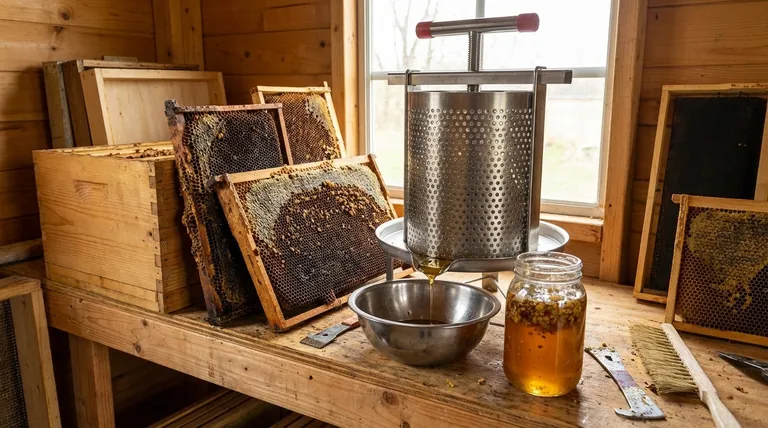The best combs for a honey press are those you do not intend to return to the hive for reuse. This specifically includes combs that are very dark from age, irregularly shaped or damaged, or heavily filled with beebread (pollen) instead of just honey.
A honey press is fundamentally a tool for salvaging honey from combs that are unsuitable for standard centrifugal extraction. While an extractor preserves the valuable wax comb, a press intentionally destroys it, making it the ideal choice for culling old or problematic frames from your apiary.

The Core Principle: Preserving vs. Sacrificing the Comb
Understanding when to use a press begins with recognizing the value of drawn honeycomb.
Why You Want to Preserve Comb
Bees expend an enormous amount of energy and resources to build honeycomb. A frame of drawn comb gives a colony a significant head start on honey storage for the next season.
Centrifugal extractors are designed to remove honey while leaving this valuable comb structure intact, allowing you to return the empty frames to the hive.
When Sacrificing Comb Makes Sense
Sometimes, the comb itself is no longer desirable or usable, but the honey within it is still perfectly good. This is the precise scenario where a honey press excels.
By pressing, you sacrifice the comb to salvage the honey. This allows you to remove unwanted frames from your hive rotation as part of good apiary management.
Ideal Candidates for the Honey Press
Certain types of comb are not only suitable for pressing but are actively poor candidates for centrifugal extraction.
Very Dark or Old Combs
Over years of use, combs become dark as they accumulate propolis, pollen, and brood cocoons. These old combs can potentially harbor pesticide residues or pathogens.
Culling them is a key practice for hive biosecurity. Pressing allows you to extract the honey before rendering the old wax for other uses.
Irregularly Shaped or Damaged Combs
Bees don't always build comb perfectly within the frame. Cross-combs, burr combs, or frames that break during inspection will not fit or will fly apart in a high-speed extractor.
A press easily handles these odd pieces, ensuring no honey goes to waste.
Combs Full of Beebread (Pollen)
Frames packed with beebread are difficult to extract cleanly. The pollen tends to clog filters and can get mixed into the honey, affecting its purity and flavor.
Pressing allows you to separate the honey from the compressed pollen and wax, which can then be dealt with separately.
Understanding the Trade-offs
Using a honey press is not a universal solution; it comes with clear advantages and disadvantages.
Pro: Maximum Honey Yield
A press can squeeze out nearly every drop of honey, often yielding more than an extractor, especially from crystallized or dense combs.
Con: Increased Labor and Filtration
Pressing is a slower, more manual process. The resulting honey also contains a higher concentration of wax particles and other debris, requiring more thorough straining and filtering.
Con: The Loss of Drawn Comb
This is the most significant trade-off. By pressing, you are destroying a resource that your bees must work hard to rebuild. This method should be reserved for combs that you have already decided must be removed from the hive.
Making the Right Choice for Your Goal
Select your extraction method based on the condition of the comb and your long-term goals for the hive.
- If your primary focus is maximizing hive productivity: Use a centrifugal extractor for your good, straight, and relatively new combs to preserve them for the bees.
- If your primary focus is salvaging honey and maintaining hive health: Use a honey press to reclaim honey from old, damaged, or pollen-heavy frames that need to be culled.
- If your primary focus is foundationless or top-bar beekeeping: A press can be your primary extraction method, as it's perfectly suited for the irregular comb shapes common to these methods.
By understanding when to press and when to extract, you can manage your hive's resources more efficiently and effectively.
Summary Table:
| Comb Type | Why It's Ideal for Pressing |
|---|---|
| Dark/Old Combs | Culls potential disease/pesticide carriers; salvages honey before wax rendering. |
| Irregular/Damaged Combs | Handles cross-combs or broken frames that won't fit in an extractor. |
| Combs Full of Beebread (Pollen) | Separates honey from pollen, preventing clogging and flavor issues. |
Ready to upgrade your honey harvesting process?
HONESTBEE supplies durable beekeeping supplies and equipment to commercial apiaries and distributors through wholesale-focused operations. We help you manage your apiary efficiently with the right tools for every task, whether you're using an extractor for good combs or a press for culling.
Contact HONESTBEE today to discuss your wholesale equipment needs and improve your honey yield and hive health.
Visual Guide

Related Products
- Easy Use Manual Stainless Steel Honey Press for Honey Comb
- Electric Honey Press Machine for Squeezing Honey Comb Press Equipment
- Stainless Steel Manual Honey Press with Guard for Pressing Honey and Wax
- 10L Stainless Steel Electric Honey Press Machine
- Stainless Steel Honey Press Wax Press with Tank
People Also Ask
- What are the recommended conditions for using a honey press? Achieve Optimal Honey Extraction
- How does a honey press work? A Guide to Simple, High-Yield Honey Extraction
- What is a honey press and how does it work? A Guide to Crush-and-Strain Extraction
- What are the reasons for choosing a honey press over a dedicated honey extractor? Maximize Disease Control and Natural Beekeeping
- What are the key features of a honey press? Maximize Yield with Durable, Efficient Extraction



















